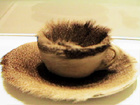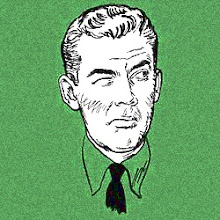
William Styron spent a year in Rome. Took a drive with friends and beloved Rose to Anzio, had a meal at a fine
ristorante recommended to them. On the drive back, Styron, at the wheel of the car, hit a motorcyclist - riding a Vespa. The man flew along the hood of the car and shattered the windshield, then was flung forward and landed on the pavement just in front of the car. The man did not die but Styron was horribly shaken. After a while, a doctor in attendance, Styron saw missing fingers and an empty eye socket. "Do not worry," said the doctor (in Italian, of course), "He lost those in the last accident."
Styron refused to drive for several weeks. And later he wrote this incident into the beginning of
Set This House on Fire, the blockbuster Styron novel of 1960.
In the novel the motorcyclist goes into a coma, from which he awakes only at the very end of the book.
Thematically the novel is a condemnation of vulgar postwar American culture. The title comes from one of John Donne's epistles to the Earle of Carlile.
Formally it's odd and interesting: Styron at one point decided to compose the second half of the novel simultaneously in the first person and the third person. And he wrote on "dexies" - amphetamines. "I liked them," he said. He felt his pencil liberated and had access to surrealistic visions. He only took them for a week or so, since the main side effect was insomnia.
Norman Mailer hated the book even before it was published. People had been talking about Styron's next big novel (
The Long March didn't quite count) after the great first book,
Lie Down in Darkness. Preparing
Advertisements for Myself, Mailer wrote that he's heard the new Styron novel is done. "If it is at all good, and I expect it is, the reception will be a study in the art of literary advancement. For Styron has spent years oiling every literary lever and power which could help him on his way, and there are medals waiting for him in the mass-media."
In the novel there's a Mailer-like character, Mason Flagg. Through Flagg (who says word for word a few things Mailer had said) Styron wanted to tell Mailer that he's been wasting his talent - especially hanging aesthetically around with the beat scene and modern jazz and free sex, which Styron deemed banal. So on page 124 of
Set This House on Fire Styron has Flagg say something that was right out of a letter Mailer had written to Styron - a private signal to Mailer that Flagg had a message for him.
Paul Pickrel, reviewing the new Styron for
Harper's, wrote: "Styron's great resource is excess." And: "The theme of the book was neatly summarized by William Blake long ago in his apothegm: 'The road of excess leads to the palace of wisdom.'"
review: July 1960 issue, p. 93; other sources including James West's excellent biography of Styron
 Beatnik Questionnaire, copyright 1960, Gimmix Novelties, White Plains, N.Y. (Harry Ransom Center)
Beatnik Questionnaire, copyright 1960, Gimmix Novelties, White Plains, N.Y. (Harry Ransom Center)




 Is '60 the moment when the end of the end of the Old Left had been reached and the New Left began to emerge? Is it the final ascendancy, in certain scenes at least, of poetic postmodernity? Surely the publication of Donald Allen's The New American Poetry that year suggests this, but then again--once again--we look back on "New" here and see continuity. The rhetoric of the Kennedy-Nixon contest made much less of a dent than everyone (at the time as well as since) claimed, so one wonders why were such great claims made?
Is '60 the moment when the end of the end of the Old Left had been reached and the New Left began to emerge? Is it the final ascendancy, in certain scenes at least, of poetic postmodernity? Surely the publication of Donald Allen's The New American Poetry that year suggests this, but then again--once again--we look back on "New" here and see continuity. The rhetoric of the Kennedy-Nixon contest made much less of a dent than everyone (at the time as well as since) claimed, so one wonders why were such great claims made?  Had we come to expect "1960" to be truly ubiquitously modern in a way that the 1950s really were not--not quite? And what specifically does "modern" mean in the Kennedyesque talk then and now about the torch being passed to a new generation, etc.? The First Lady really meant "modernist" when Camelotians said "modern." What about the others across the new young cultural leadership? I've been surprised by how frequently the
Had we come to expect "1960" to be truly ubiquitously modern in a way that the 1950s really were not--not quite? And what specifically does "modern" mean in the Kennedyesque talk then and now about the torch being passed to a new generation, etc.? The First Lady really meant "modernist" when Camelotians said "modern." What about the others across the new young cultural leadership? I've been surprised by how frequently the  "Beat movement" was covered in 1960 in the mainstream press. I was expecting a fair measure but I've found tonnage. 1960 was the year when the figure of the beat was beginning to find acceptance, although still 80% of these stories are mocking, rebels-without-cause condescension. For anyone whose analysis made an impact nationally, do these antipolitical adolescents count as part of the "new young cultural leadership"? No, but rather than the two being opposites, they fall along a Continuum of the New American. Now that's a change for '60.
"Beat movement" was covered in 1960 in the mainstream press. I was expecting a fair measure but I've found tonnage. 1960 was the year when the figure of the beat was beginning to find acceptance, although still 80% of these stories are mocking, rebels-without-cause condescension. For anyone whose analysis made an impact nationally, do these antipolitical adolescents count as part of the "new young cultural leadership"? No, but rather than the two being opposites, they fall along a Continuum of the New American. Now that's a change for '60.







